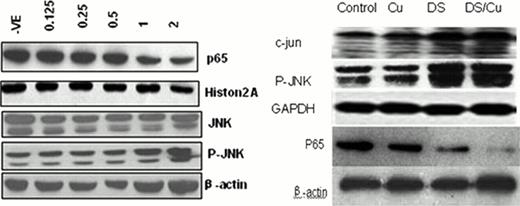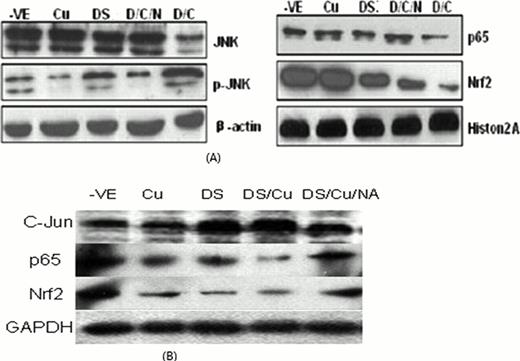Abstract
Abstract 4869
Disulfiram (DS), an antialcoholism drug, demonstrates strong antitumor activity in a copper (Cu)-dependent manner. Our previous study showed that it is highly cytotoxic in doxorubicin resistant leukemia cells and enhances cytotoxicity of doxorubicin. DS/Cu induces reactive oxidative stress (ROS) which activates stress related signaling pathway (c-Jun-amino-terminal kinase, JNK). Cancer cells possess higher ROS activity and some antiapoptotic factors. Therefore cancer cells may be effectively targeted by simultaneous inducing ROS and inhibiting antiapoptotic factors. Our study investigated the cytotoxicity of DS/Cu complex in acute lymphoblastic leukemia and Burkitt's lymphoma cell lines.
MTT assay showed that at a low concentration (1μM) of Cu2+, DS induces cytotoxicity to Molt4 and Raji cells with IC50s of 0.435±0.109μM and 0.085±0.015μM respectively. The morphology and Annexin-V/PI flow cytometric analysis indicated that DSF/Cu induced apoptosis of Molt4 and Raji cells. The apoptotic proportion of Molt4 cells increased from 17.75% to 79.5% when exposed to increasing concentrations of DS (0.125, 0.25, 0.5, 1μM) for 24h. The DS/Cu induced apoptosis is also time-dependent. The apoptotic proportion of Raji cells increased from 18.89±5.86% to 81.03±7.91% when exposed to DS (3.3μM) and Cu (1μM) for 6, 12 and 24h. Nrf2 is a key antioxidant factor. Western blot indicated that Nrf2 nuclear translocation was changed in a time-dependent manner after cells being treated by DS/Cu. Nrf2 expression was increased when Raji cells were treated for less than 12h and decreased after 18h or 24h treatment (Figure 1). Inhibition of Nrf2 could also be seen in Molt4 cells after 24h treatment. QT-PCR showed that DS/Cu down-regulated Nrf2 gene expression in a concentration dependent manner. ROS levels are closely related to Nrf2. Flow cytometric analysis showed that DS/Cu induced ROS generation. Western blot manifested that DS/Cu complex induced phosphorylation of JNK expression and inhibited P65 activity (Figure 2). N-acetyl-L-cysteine (NAC), an antioxidant, can partially attenuate DS/Cu complex-induced apoptosis, restore Nrf2 nuclear translocation, reactivate P65 activity and block JNK activation (Figure 3).
In conclusion, our study showed that DS/Cu induces apoptosis in vitro and shows anticancer activity in vivo to lymphoid malignancy cell lines. We also demonstrated that ROS played a key role in DS/Cu- induced apoptosis. ROS can partially inhibit P65 activity and activate JNK while having bi phase regulation of Nrf2 expression. The initially increased Nrf2 expression decreases after 18h and 24h treatment. Therefore the DS/Cu induced ROS may be higher than that antioxidant factors could protect and thus the Nrf2-mediated cellular survival mechanism was disabled through down regulation of Nrf2 to allow initiation of death process.
Bi phase regulation (right) and decrease (left) of Nrf2 expression in Molt4 (left) and Raji (right) cells
Bi phase regulation (right) and decrease (left) of Nrf2 expression in Molt4 (left) and Raji (right) cells
Inhibition of P65 activity and activation of JNK by DS/Cu in Molt4 (left) and Raji (right) cells
Inhibition of P65 activity and activation of JNK by DS/Cu in Molt4 (left) and Raji (right) cells
Partially restoration of Nrf2 nucelar translocation, block of inhibition of P65 activity and activation of JNK in Molt4 (A) and Raji (B) cells
Partially restoration of Nrf2 nucelar translocation, block of inhibition of P65 activity and activation of JNK in Molt4 (A) and Raji (B) cells
No relevant conflicts of interest to declare.
Author notes
Asterisk with author names denotes non-ASH members.




This feature is available to Subscribers Only
Sign In or Create an Account Close Modal